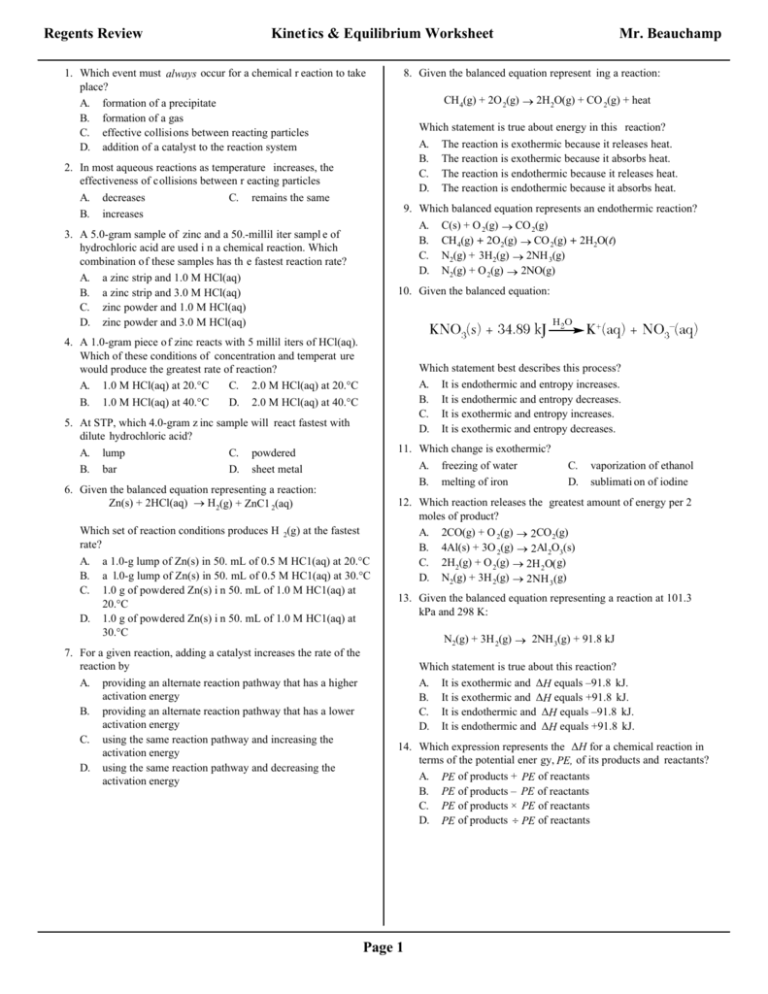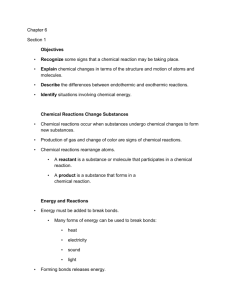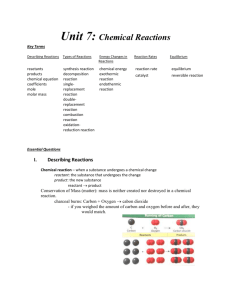the Kinetics & Equilibrium Regents Review Worksheet with answers.
advertisement

Regents Review Kinetics & Equilibrium Worksheet 1. Which event must always occur for a chemical r eaction to take place? A. formation of a precipitate B. formation of a gas C. effective collisions between reacting particles D. addition of a catalyst to the reaction system 2. In most aqueous reactions as temperature increases, the effectiveness of collisions between r eacting particles A. decreases C. remains the same B. increases 8. Given the balanced equation represent ing a reaction: CH 4(g) + 2O 2(g) → 2H 2O(g) + CO 2(g) + heat Which statement is true about energy in this reaction? A. The reaction is exothermic because it releases heat. B. The reaction is exothermic because it absorbs heat. C. The reaction is endothermic because it releases heat. D. The reaction is endothermic because it absorbs heat. 9. Which balanced equation represents an endothermic reaction? A. C(s) + O 2(g) → CO 2(g) B. CH 4(g) + 2O2(g) → CO 2(g) + 2H2O(…) C. N2(g) + 3H2(g) → 2NH 3(g) D. N2(g) + O 2(g) → 2NO(g) 3. A 5.0-gram sample of zinc and a 50.-millil iter sampl e of hydrochloric acid are used i n a chemical reaction. Which combination of these samples has th e fastest reaction rate? A. a zinc strip and 1.0 M HCl(aq) B. a zinc strip and 3.0 M HCl(aq) C. zinc powder and 1.0 M HCl(aq) D. zinc powder and 3.0 M HCl(aq) 10. Given the balanced equation: 4. A 1.0-gram piece o f zinc reacts with 5 millil iters of HCl(aq). Which of these conditions of concentration and temperat ure would produce the greatest rate of reaction? A. 1.0 M HCl(aq) at 20.°C C. 2.0 M HCl(aq) at 20.°C B. 1.0 M HCl(aq) at 40.°C D. 2.0 M HCl(aq) at 40.°C Which statement best describes this process? A. It is endothermic and entropy increases. B. It is endothermic and entropy decreases. C. It is exothermic and entropy increases. D. It is exothermic and entropy decreases. 5. At STP, which 4.0-gram z inc sample will react fastest with dilute hydrochloric acid? A. lump C. powdered B. bar D. sheet metal 11. Which change is exothermic? A. freezing of water B. melting of iron 6. Given the balanced equation representing a reaction: Zn(s) + 2HCl(aq) - H2(g) + ZnC1 2(aq) Which set of reaction conditions produces H 2(g) at the fastest rate? A. B. C. D. a 1.0-g lump of Zn(s) in 50. mL of 0.5 M HC1(aq) at 20.°C a l.0-g lump of Zn(s) in 50. mL of 0.5 M HC1(aq) at 30.°C 1.0 g of powdered Zn(s) i n 50. mL of 1.0 M HC1(aq) at 20.°C 1.0 g of powdered Zn(s) i n 50. mL of 1.0 M HC1(aq) at 30.°C 7. For a given reaction, adding a catalyst increases the rate of the reaction by A. providing an alternate reaction pathway that has a higher activation energy B. providing an alternate reaction pathway that has a lower activation energy C. using the same reaction pathway and increasing the activation energy D. using the same reaction pathway and decreasing the activation energy Mr. Beauchamp C. D. vaporization of ethanol sublimati on of iodine 12. Which reaction releases the greatest amount of energy per 2 moles of product? A. 2CO(g) + O 2(g) → 2CO 2(g) B. 4Al(s) + 3O 2(g) → 2Al 2O3(s) C. 2H2(g) + O 2(g) → 2Η 2Ο( g) D. N2(g) + 3H 2(g) → 2ΝΗ 3(g) 13. Given the balanced equation representing a reaction at 101.3 kPa and 298 K: N2(g) + 3H 2(g) → 2NH 3(g) + 91.8 kJ Which statement is true about this reaction? A. It is exothermic and (H equals –91.8 kJ. B. It is exothermic and (H equals +91.8 kJ. C. It is endothermic and (H equals –91.8 kJ. D. It is endothermic and (H equals +91.8 kJ. 14. Which expression represents the (H for a chemical reaction in terms of the potential ener gy, PE, of its products and reactants? A. PE of products + PE of reactants B. PE of products – PE of reactants C. PE of products × PE of reactants D. PE of products ^ PE of reactants Page 1 Kinetics & Equilibrium Worksheet 15. Given the potential en ergy diagram for a reaction: Which interval on this diagram represents the difference between the potential energy of the products and the potential energy of the reactan ts? A. 1 C. 3 B. 2 D. 4 16. Given the potential energy diagram for a chemic al reaction: 17. Given the potential energy diagram of a c hemical reaction: Which arrow represents the potential energy of the reactants? A. B. C. D. A B C D 18. The activation energy required for a chemical reaction can be decreased by A. increasing the surface area of the reactant B. increasing the temperature of the reactant C. adding a catalyst to the reaction D. adding more reactant 19. Which statement must be true when solution equilibrium occurs? A. The solution is at STP. B. The solution is supersaturated. C. The concentration of the solution remains constant. D. The masses of the dissolved solute and the undissolved solute are equal. 20. Given the equation representing a phase change at equilibrium: C 2H5OH(…) ↔ C2H5OH(g) Which statement is true? A. B. C. Which statement correctly describes the ene rgy changes that occur in the forward reaction? A. The activation energy is 10. k J and the reaction is endothermic. B. The activation energy is 10. k J and the reaction is exothermic. C. The activation energy is 50. k J and the reaction is endothermic. D. The activation energy is 50. k J and the reaction is exothermic. D. The forward process proc eeds faster than the reverse process. The reverse process proceeds faster than the forward process. The forward and reverse processes proceed at the same rate. The forward and reverse processes both stop. 21. A solution that is at equilibrium must be A. concentrated C. saturated B. dilute D. unsaturated Page 2 Kinetics & Equilibrium Worksheet 22. Which balanced equation represents a phase equilibrium? A. 26. Given the system at equilibrium: N2O4(g) + 58.1 kJ * 2 NO 2(g) B. What will be the result of an increase in temperature at constant pressure? A. The equilibrium will shi ft to the left, and the concentration of NO 2(g) will decrease. B. The equilibrium will shi ft to the left, and the concentration of NO 2(g) will increase. C. The equilibrium will shift to the right, and the concentration of NO 2(g) will decrease. D. The equilibrium will shift to the right, and the concentration of NO 2(g) will increase. C. D. 23. Ammonia is produced comm erciall y by the Haber reaction: N2(g) + 3 H 2(g) ↔ 2 NH 3(g) + heat 27. In terms of energy and entropy, systems in nature tend to undergo changes toward A. higher energy and higher entropy B. higher energy and lower entropy C. lower energy and higher entropy D. lower energy and lower entropy The formation of ammonia is favored by A. B. an increase in pressure a decrease in pressure C. D. removal of N 2(g) removal of H 2(g) 24. Given the equation representing a reaction at equilibrium: 28. Which list of the phases of H 2O is arranged in order of increasing ent ropy? A. ice, steam, and liquid water B. ice, liquid water, and steam C. steam, liquid water, and ice D. steam, ice, and liquid water Which change causes the equilibr ium to shift to the right? A. B. C. D. decreasing the concentration of H 2(g) decreasing the pressure increasing the concentration of N 2(g) increasing the temperature 29. Given the balanced equation: I 2(s) + ene rgy →I2(g) 25. Given the system at equilibrium: As a sample of I 2(s) sublimes to I 2(g), the en tropy of the sample Which changes occur when O 2(g) is added to this system? A. The equilibri um shifts to the right and the concentration of PCl 3(g) increases. B. The equilibri um shifts to the right and the concentration of PCl 3(g) decreases. C. The equilibri um shifts to the left and the concentration of PCl 3(g) increases. D. The equilibri um shifts to the left and the concentration of PCl 3(g) decreases. Page 3 A. B. C. D. increases because the particles ar e less randomly arranged increases because the part icles are more randomly arranged decreases because the particles are less randomly arranged decreases because the part icles are more randomly arranged Kinetics & Equilibrium Worksheet Base your answers to questions 30 and 31 on the information below. The equilibri um equation below is related t o the manufacture of a bleaching solution. In this equation, C1(aq) means that chlorid e ions are surrounded by water molecules. 30. Explain, in terms of collision theory, why increasing the concentration of C1 2(g) increases t he concentration of OCL ‚(aq) in this equilibrium system. 31. Use the key to draw two water molecules in the box, showing the correct orientation of each water molecule toward the chloride ion. Base your answers to questions 32 through 34 on the equation below. 2H 2(g) + O 2(g) - 2H 2O(…) + 571.6 kJ 32. Explain why the entropy of the system decreases as the reaction proceeds. 33. Identify the information in this equat ion that indicates the reaction is exothermic. 34. On the axes below, draw a potential energy diagram for the reaction represented by this equation. 35. Explain, i n terms of collision theory, why the rate of a chemic al reaction increases with an increase in temperature. Page 4 Kinetics & Equilibrium Worksheet Base your answers to questions 36 through 38 on the information below. An investigation was conducted to study the effect of the concentration of a reactant on the total t ime needed to complete a chemical reaction. Four trials of the same reaction were performed. In each trial the initial concentration of the reactant was different. The time needed for the chemical reaction to be completed was measured. The data for each of the fo ur trial s are shown in the tabl e below. 36. In a different experiment involv ing the same reaction, it was found that an increase in temperature i ncreased the rate of the reaction. Explain this resul t in terms of collision theory. 37. a On the grid, mark an appropriate scale on the axis labeled “Reaction Time (s).” An appropriate scale is one that allows a trend to be seen. b On the same grid, plot the data from the data table. Circle and connect the points. 38. State the effect of the concentration of the reactant on the rate of the chemical reaction. Page 5 Kinetics & Equilibrium Worksheet Answer Key 1. C 2. B 3. D 4. D 5. C 6. D 7. B 8. A 9. D 10. A 11. A 12. B 13. A 14. B 15. D 16. B 17. B 18. C 19. C 20. C 21. C 22. C 23. A 24. C 25. D 26. D 27. C 28. B 29. B 2(g) and OH –(aq) 31. 32. Examples: – A liquid is formed from gases. – A compound is formed from its ele ments. – The number of gas particles in the system decreases. 33. Examples: – Heat term is on the right side of the equation. – The 571.6kJ is a product. 34. 35. As temperature increases, the r ate of a chemical reaction inc reases because the reactant par ticles move faster and collide more of ten. 36. Examples: – The greater the kinet ic energy of the reactant particles, the greater the frequency and effectiveness of the collisions. – Increasing the temperature causes more collisions. more effective collisions 37. 30. Examples: – The concentrati on of OCl– (aq) increases because there will be a greater number of effecti collisions between the Cl 2(g) and the OH –(aq) – more collisions between Cl 38. Examples: – As concentration of the reactant decrease s, the r ate of the reaction decreases. – As concentration increases, the rate of reaction increases.









